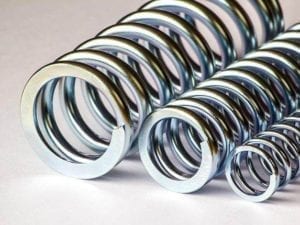 Helical springs are those familiar elastic coiled mechanical devices that are used to store and release energy. As a mechanical device, they are integral components for applications in nearly every industrial sector. The sheer amount of applications of helical spring in all areas of modern life is staggering. Helical springs are found in consumer goods, medical devices, in the manufacture of parts for the automotive, aerospace and transportation industries, for the construction industry, and in the making of tools, machinery and equipment, and so forth. They vary in size and shape, from micro designs for use in electronic applications and medical devices to large industrial-sized foundational dampeners for buildings and bridges.
Helical springs are those familiar elastic coiled mechanical devices that are used to store and release energy. As a mechanical device, they are integral components for applications in nearly every industrial sector. The sheer amount of applications of helical spring in all areas of modern life is staggering. Helical springs are found in consumer goods, medical devices, in the manufacture of parts for the automotive, aerospace and transportation industries, for the construction industry, and in the making of tools, machinery and equipment, and so forth. They vary in size and shape, from micro designs for use in electronic applications and medical devices to large industrial-sized foundational dampeners for buildings and bridges.
Benefits of Helical Springs
Of their many benefits, helical springs are valued most for their functionality and the simplicity in which they can store mechanical energy. Helical springs also referred to as coiled springs, are, essentially, no more than tightly wound cylindrical mechanisms that are designed to support different types of loads. These cylindrical mechanisms then, serve as a simple, mechanical component that enables devices, tools, structures, and machines, or various kinds of equipment and products, to function. It is no less than an engineering marvel. Helical springs can be manufactured to absorb, eject, twist, or maintain a compressive, tensile, or torque force or energy between surfaces. Once the potential energy from the spring is released, the elastic coil returns to its original helical-shaped form.
Common Types
Helical springs come in several varieties that relate to their function and application. The most prominent and main kinds of helical springs are compression, extension, and torsion. Each is designed to carry a specific type of load. As each name implies, the specific design of a spring represents its mechanical application and how its potential energy is stored. Thus, the best way to recognize one type of spring from the other is to understand the application.
Compression
The most common helical spring on the market is the compression spring. The open-coil design is set at a pitch intended to provide resistance when force is applied. The springs come in many shapes and sizes—hourglass, barrel or conical, e.g.—but all are designed to acts as a compressive force to buffer or absorb the energy of a particular load. Compression springs are placed in round holes or slots, or over shafts or rods, where resistance to linear compression is needed. They are found in many diverse applications in as many industries. From ballpoint pens, furniture, air turbines, guidance systems, engine controls, fuel cells and engines to inhalers, pill dispensers, syringes, diagnostic devices, medical staple guns, surgical tools, catheters, valves, vehicle suspensions, electrical switches, cellphones and button-operated devices.
Extension
Extension springs also referred to as tension springs, are tightly wound coiled springs that have loops or hooks at either end. This design feature attaches separate components to each other. As the components move apart, extension springs work to bring them back together, creating a resistance to a pulling force. How tightly together an extension spring is coiled, its initial tension depends on the load requirements of the spring. The further a device is pulled apart and extended, the greater energy is needed to return components back to a neutral position. Tension springs have many applications and are used across many industry sectors, from energy, automotive, and agriculture to aerospace, medical and consumer goods. Extension springs are found in washing machines and dryers, medical devices like stretchers and surgical lights, tools like vice-grip pliers, in farm machinery assemblies, automotive interiors and exteriors, for garage doors, to extend or retract aircraft landing gears and to hold equipment to oil rigs in off-shore applications, and even snowplows.
Torsion
Torsion springs are spiral-shaped springs that store energy when twisted or rotated on its axis. Once the spring is loaded, it utilizes a torque force proportional to the amount of force being applied to it in the opposite direction—think of how a mousetrap works. Torsion springs are used wherever a rotational or torque force is required. They are most commonly used in door hinges—garage doors, automobile doors, industrial heavy-duty overhead doors on loading docks and warehouses, and common screen porch doors rely on the torsion spring to function. The clamping mechanism of a clothespin is from a torsion spring. Spiral torsion springs are used in mechanical watches, clipboards, levers and switches of all shapes and sizes.
Known for their reliability, durability, simplicity, and precision, helical springs are indispensable elastic coil devices used to store the mechanical energy necessary for products to function. Though fundamentally a simple mechanical device, helical springs are designed to support various types of loads—compressive, tensile and torque. From common household products and tools to advanced aeronautical applications and medical equipment, helical springs remain essential components that are widely used by industries throughout the world.
Custom Helical Spring Manufacturing
James Spring and Wire Company has successfully partnered with fabricators, engineers, and design firms alike in the design and manufacture of custom helical springs. Our in-house engineering department can help you with your spring design to ensure that your design specifications are met and the best, quality spring is manufactured for your application. To learn more contact James Spring and Wire today.

